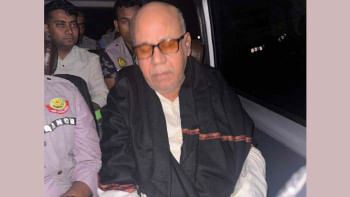A girl's struggle against child marriage

Author: Shahazada Basunia || Published in Dhaka by Tofazzal Hossain, First Edition: June 2016. PP. 128
Reviewed By Bayezid Dawla
Love in Teary Eyes' is a novel by Shahazada Basunia depicting the love story of Aurnob and adolescent Tripti who revolted against the social taboo of child marriage. Aurnob, a university student and Tripti, an adolescent schoolgirl, find good friends in each other and fall in love—a relationship of common understanding, trust and shared commitment to combat social ills, especially the curse of child marriage.
The love story opens with heroine Tripti fleeing home to escape the marriage her father arranged with a local goon named Kamrul Sikder. Kamrul lent money to her father, Rahman Sarker and established a patron-client relationship between them but the latter's repayment failure created an opportunity for the former to press for his marriage with Tripti. Tripti rejects the arrangement being a disgrace to her life, manages to flee home and finds shelter at the house of Aurnob in a neighboring village.
Aurnob and his parents welcome Tripti to stay with them in their house. Next day, Aurnob visits her parents, comes to know that Rahman and his father , Nazrul Master, were school friends, and invites the "uncle" to take his daughter back but Tripti refuses to "see the face" of her father. Rahman returns home with a broken heart.
Kamrul discovers Tripti's hideout and threatens Nazrul to give her back to him. Instead, Nazrul Master makes a resolve to teach him a good lesson and gets the girl admitted to the school where he teaches. Aurnob's summer vacation ends. The day before his return to his study, Aurnob and Tripti visit her parents and on way back at night they are attacked by Kamrul. They fight him and leave the assailant injured. Kamrul lodges an attempt-to-murder case against Aurnob. The local police nab Aurnob but the court finds them innocent and releases Aurnob from the charge.
However, Nazrul treats Tripti as a curse in the life of his son, and conspires with Kamrul to evict the girl from his house and the school. He helps the villain to kidnap Tripti from his house at midnight and also mobilizes his colleagues to expel the "bad girl" from the school. But the headmaster takes the side of Tripti and foils the evil attempts of his fellows.
Aurnob goes back to the university and falls in love with his girlfriend, Sumona. Sumona with "love in teary eyes" discloses to him a secret that she is a victim of child marriage and that she lives with a husband she has never liked.
Disappointed, Aurnob makes up his mind to marry Tripti but his father opposes his son's decision. Aurnob is determined and eventually wins the hand of Tripti after a long struggle with his father. The novel ends with Aurnob marrying Tripti, a 15-year old adolescent girl. The police, however, intervene at the instigation of Kamrul's father but accept the villagers' decision that "the newly married couple cannot live together until they become adults".
This story is set mostly in two neighboring villages—Monerkutir and Sarkerpara—in Razurhat Upazila of Rangpur district, the birthplace of the novelist, indicating that the characters he has created and set to play in different grounds of actions have grown in a semi-real rural background he has known since his boyhood.
The overarching theme the novel deals with is the taboo of child marriage and gender discrimination and male violence against women, which is engineered to maintain the patriarchal social system. The heroine's escape from the matrimonial arrangement is symbolic of revolt that challenges the social convention embedded in the rural power structure as well as the authority of money and muscle exercised by terrorist acts of villain Kamrul Sikder. The dialogical engagements of the protagonists in mobilizing "social resilience" against the unjust tradition of a social engine stimulate the rebelliousness unfolding in their consciousness and its transformational change into various forms of denial, protest and subjugation that boost up varying actions at the energetic level.
Passion governs the diverse interests and actions in the portrayal of the characters. Essentially, this gives rise to a struggle in the two passionate souls of the hero and the heroine for eliminating the stigma and taboos as well as building a society that recognizes and treats individuals with equal dignity and worth, not based on sexual discrimination. The novelist has demonstrated his craftsmanship in the delineation of passion that awakens love in the hearts of the hero and the heroine and violence in the actions of the villain.
A special feature of the novel is the functioning of the rural power structure that dominates the progress of the work and of the hierarchy that makes uses of the stigma to maintain the culture of women's subordination to men. This refers to the different interests and roles represented by the stakeholders participating in the village meeting convened by the "matbar", which focuses attention on how the social institutions work to serve multiple purposes.
The portrayal of characters is reinforced by the dramatization of conflicts (physical, inner and intra), contrast and comparison between evil and good, rhetoric and practice, and appearance and reality, which are major features of conspiracy and contradictions at the individual and social levels. The novel concludes purveying an ironic contrast with the ideological struggle and commitment overpowered by the institutionalization of the taboos and manifestation of evil forces in the "fabricated society".
The story has been narrated in lucid English, which adds much value to the brilliance of presentation and seems to encourage a wide read of the novel.
The reviewer is Executive Director, Civic Bangladesh and General Secretary, Bangladesh Dignity Forum. Email: bdawla@civic bd.org


 For all latest news, follow The Daily Star's Google News channel.
For all latest news, follow The Daily Star's Google News channel. 



Comments